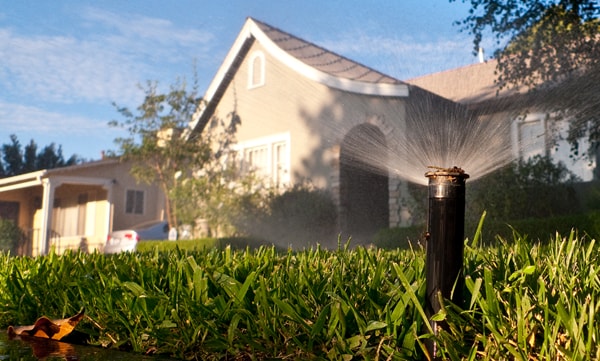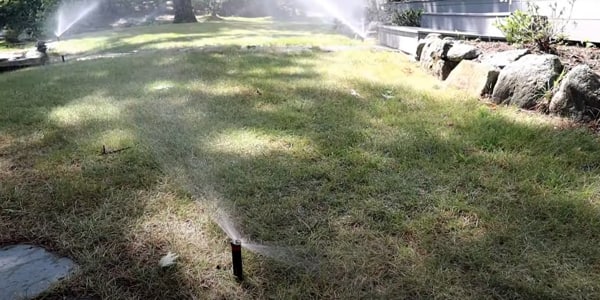Here’s a list of all the possible solutions that you can try to solve this problem. Make sure you check local laws before doing well maintenance.
Wait for Some Time: The basic reason a well pump cannot keep up with sprinklers is the lack of water in your well. Give your well some time to replenish before you can run sprinklers again. Each well’s recovery rate may differ, so you may want to wait for at least a day.
Check Water Treatment Unit: Is your sprinkler system connected to a water treatment unit like a softener or a sediment filter? Check if it is blocked or clogged. Clean and then test the sprinkler system. We recommend you bypass water treatment units from your sprinkler system.
Inspect Lawn Irrigation Pump: Many homes with large lawns use a lawn irrigation pump. It is used to increase water pressure before the water reaches sprinklers. Inspect it and see if it is working all right.
Check the Pump: Pull out the pump and examine it for any wear or tear. Well pumps can lose their drawing capacity over time. This can lead to your sprinkler system not working properly because the well pump cannot supply water at a constant pace. You don’t notice this in your home because a sprinkler system draws water rapidly. It is more demanding than opening all your home taps at once.
Inspect the Pressure Switch: The pressure switch controls the settings at which the pump turns on or off. The common settings on a pressure switch are 20/40, 30/50, or 40/60 PSI. The pump kicks in when the water pressure goes beyond the low point (20, 30, 40 PSI) and turns off when it reaches the high point (40, 50, 60 PSI).
The pressure switch can go bad over time to lose its working power. Examine the contacts on the switch, and replace them if they wear and tear.
Check Pressure Tank: Check the air pressure in the pressure tank by connecting a standard tire pressure gauge to the air nozzle at the top of the tank. The reading on the gauge must be 2-3 PSI below the low point setting on the pressure switch. For example, if the pressure switch is set to 40/60 PSI, the reading on your pressure tank must be 37-38 PSI.
You can drain the pressure tank to see if the bladder isn’t broken. Your pressure tank is damaged if you hear a water swishing sound in the tank. If there is no water sound inside, set the pressure tank to 38 PSI if the setting on the switch is 40/60 PSI.
Check Sprinkler System: Check for leaks in the sprinkler system. Sometimes the sprinkler system can have leaks and holes, increasing water drawdown drastically.
Clogged Well Screen: The well screen is a protective mesh that stops sediment, rock, and leaves from entering the bottom of your well. These particles can gather around the screen and block water from reaching your well. You can clean the screen using a cleaner like NuWell or hire a local contractor.

Test for Water Flow: Another diagnostic test you can run to see what’s wrong is to check water flow right at the well head. Turn off the well pump and remove the water pipe coming out of the pump. Ensure you place the pipe in a large container to avoid spills and damage to nearby equipment. Now turn on the pump and notice the water flow.
If the water comes out fast and the flow rate is good for a few minutes but drops suddenly, your well is not producing enough water. There could be sediment buildup on the well screen, or the aquifer has lost its water potential.
If the water comes out slow and stays that way, something is wrong with your well pump. You need to get it checked by a certified well contractor.
Limit your Sprinkler System Size: Sprinkler not watering problems can also happen if you have a large sprinkler compared to your well’s output. Consult a local well contractor and modify your sprinkler according to your well’s production capacity.
Add a Holding Tank: You may want to add a holding tank to your well water system. A holding tank is a simple water tank that holds water for low-producing wells. The water gathers in the holding tank, and then a jet pump transfers water to the pressure tank.
Adding holding tank increases water holding capacity but it can cost a lot. Moreover, the system needs to be designed carefully by a well professional.
Add a Separate Well Pump: You can use a separate well pump to avoid sprinkler running dry problems on well water. The dedicated pump for the sprinkler system will not reduce water pressure in your home. However, it may not be possible in all wells. Consult a local contractor for information on this.
Build an Irrigation Well: A dedicated irrigation well is recommended if you have large lawns and gardens. Irrigation wells require more space as they need heavy equipment. You’ll need permission from your state’s water division to build irrigation well on a residential property.

Why my Well Pump can’t keep up with Sprinklers? Common Causes
Pumping Air: Excessive water drawdown forces the water level to go below the pump’s propeller, resulting in air being pumped. Well pumps are designed to pump only water; their pumping capacity decreases when they suck air.
More Water Usage: You may be using more water than what your well and pump can deliver at one point in time. Often shallow wells have this issue. They can’t keep up with sprinklers.
If your sprinklers have stopped working recently, this could indicate pump problems or a change in hydrology; water is pumped faster than recovered.
